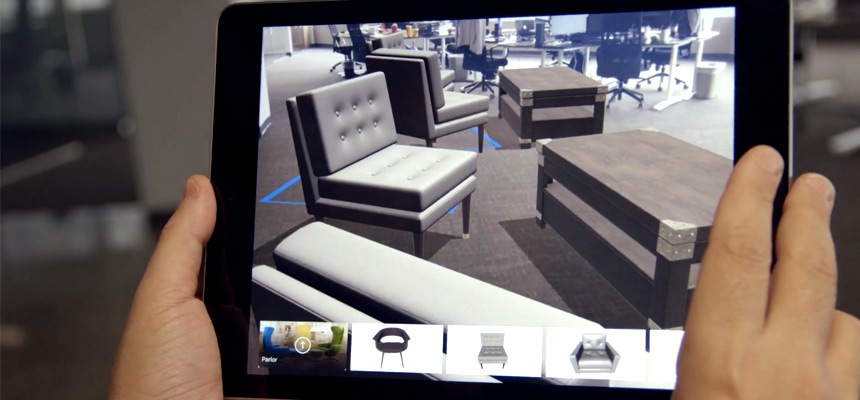
Apple’s iOS11 and ARKit is here!
Apple’s ARKit has been a big hit in the tech world since its unveiling at June’s Worldwide Developer Conference. The software toolset, which makes Markerless Augmented Reality a native feature in Apple devices running at least an A9 chip and the iOS11 operating system, was immediately embraced by developers looking to take it for a test drive. We’ve been testing ARKit here at 3D Cloud, and the SDK provides a stable and surprisingly robust solution for building AR-enabled apps for Apple devices. It’s got us hyped for the future of AR apps on Apple’s iOS11 operating system and beyond.
To give you an idea of how ARKit works, here’s a demo we developed:
As you can see, ARKit provides device, and to some extent, environmental tracking functionality. It uses the iPad’s camera to read the space and provides an Application Programming Interface (API) for obtaining the 6 degrees of freedom position and rotation of the device within the world. In addition, ARKit provides basic functionality for identifying planar surfaces (just horizontal for now, though vertical planes like walls can’t be far behind).
The next level of Augmented Reality visualization is Design In Room™ AR, which allows the products in a scene to interact. Here’s an example using an end table and a lamp:
ARKit Demos: Building the future one experiment at a time
ARKit has already been downloaded thousands of times, and innovative developers have been trying their hand at building apps. Some of these demos are downright amazing, and do a terrific job of illustrating that the only limit to what ARKit can do is the ingenuity of the dev. Here’s some of our favorites:
A-Ha! A fresh “Take” on ARKit
A-Ha’s “Take On Me” is one of the all-time great music videos, and it provided the inspiration behind this amazing ARKit Demo by Trixi Studios. “We are giant fans of the original video by Aha and director Steve Barron, and especially the legendary animators Michael Patterson and Candace Reckinger who came up with the beautiful technique and style we were trying to emulate,” Trixi explains in the video notes. “This work was made very quickly and just for fun, there is a lot of room for improvement. … Everything is live in camera and works as shown.”
Van Gogh’s bedroom like you’ve never seen it before
Augmented Reality figures to have a huge effect on education, though until now that impact has largely been theoretical. The above demo, produced by Mark Dawson, shows off an AR reproduction of Vincent Van Gogh’s bedroom, and is the first step toward an interactive learning experience that will revolutionize education. Note that the video provides a good look at how ARKit sizes up a flat surface, and then firmly affixes the 3D rendering of the house to it — even when Dawson walks all the way around the table.
AR Beer Pong: Actual suds not included
Moving from ARKit’s potential in education to its certain future as a great distractor of students, the Ezone beer pong demo is funny, and represents a legitimate stab at taking a real world game and converting it into AR. Note: You will have to provide your own libations, as computer scientists have yet to crack the “how do I drink a 3D model?” conundrum.
A measured response to ARKit
Using Augmented Reality to make real-world measurements is one of the best features of Google’s Tango platform. Tango uses a special combination of lasers and sensors to “read” a room and calculate the distances between points. While not as powerful, ARKit manages to allow for distance calculation without special hardware — as you can see in the above tape measure demo from Laan Labs.
Get in my belly!
Who’s hungry? We can only imagine that developer Alper Guler was starving after he completed the above demo, which shows off ARKit’s ability to recreate realistic food items. In addition to making us really want a bacon cheeseburger, Guler’s demo is a hint that restaurant ordering may be due for a big-time digital makeover.
Take me to your leader
Another useful trick devs are leveraging out of ARKit is its ability to identify people within a scene. The crew at Resight put together the above demo, which shows an ARKit app identifying human beings and marking them with a cute little heart that hovers over their heads. It may seem like a small thing, but software that can recognize human beings and intermingle them with digital images will be a bedrock AR feature.
Here’s a few more, added after this story was first posted:
IKEA Place
AR Food Ordering
ARived
Experiment with ARKit
Apple iOS11 AR apps now available for download
Major retailers are scrambling to hop on the AR bandwagon. Here’s the latest from some major names in retail:
Amazon AR View
Wayfair 3D/AR Video
Anthropologie AR app
ARKit’s amazing! So what’s the rub?
The ARKit demos above show off some of what the SDK can do, but there are also plenty of things that ARKit does NOT do. For example, ARKit doesn’t provide services for content management, creation and storage. Apple’s SDK just provides features for the device operating system, which devs are then free to leverage in their apps. As such, the usefulness of ARKit apps at the enterprise level will be limited without an enterprise-level content management system — something the developers will either have to create themselves, or look to a third party tool like 3D Cloud™.
If the app you’re developing uses more than a few dozen 3D models, you’re going to need CMS support from someone outside of Apple. Embedding content into an app also opens the door to issues ARKit is unequipped to deal with. If a developer needs to update the content or fix an error in one of the models, they have to release a whole new version of the app — UNLESS they are working with a networked content management system that allows for the content to be updated separate from the app.
These ARKit demos are just the beginning
ARKit makes integrating AR into apps a snap, and the platform is almost certain to drive demand for 3D content and content management at tremendous scale. With ARKit providing rock-solid tracking, developers are now using game/rendering engine like Unity to provide the functionality for all of the other features. And who knows what the future holds from Apple? The rumor mill says the next iteration of the iPhone may include Tango-like lasers for delivering an even more robust AR experience. Is it September yet?










